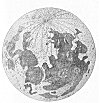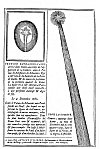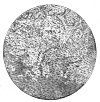
Sacred Texts Earth Mysteries Index Previous Next

The third and fourth catastrophes of the Earth are the Deluge, and the sinking of Atlantis--Atlantis the fabulous continent, not the little Island remnant. Their time sequence in the old traditions is a little mixed, not that it matters. Suppose we take first the Deluge.
The Comet, that blazing terror of the skies, that erratic wanderer of the heavens, has always been given more than its probable share of blame for terrestrial bad luck. It has been called the cause of the birth of the Moon; it has also been held responsible for the universal Deluge. This is another of those untraceably old traditions, but we begin with the Comet of 1680, and the remarkable egg laid at Rome on December 4 of the Comet-year; because this Comet and this egg are responsible for two "Theories of Earth" written within the next twenty years, both by Englishmen. William Whiston worked out a complete theory of a deluged, because Comet-riven, Earth, and Thomas Burnet developed his theory of Earth as the Mundane

Click to enlarge
PLATE XIII. One of the oldest drawings of the Moon. by Pere Capucin Marie de Rheita (1645). At the top Tycho is seen in full view, with its diverging rays.
(From Iter Exstaticum Coeleste; Athanasius Kircher, 1660)
[paragraph continues] Egg whose broken shell unlocked the "waters of the deep."
The evidence in the case is at hand in the shape of the elaborate frontispiece to Lettre d’un gentil-homme de province à une dame de qualité sur le sujet de la Comete, a brief little labour of informative love published anonymously in 1681, but known now to have been written by Claude François Manestrier. "An extraordinary freak of nature," it reads, "occurred in Rome, at the time of the appearance of the Comet, in the Palace of the Maximi, which was seen by His Holiness, by the Queen of Sweden, and by all persons of the first rank in Rome. The design of it was sent to Paris, as an entirely new thing, by a per-son greatly interested and worthy of confidence. On the 4th of December, 1680, in the Palace of the Maximi, a hen laid an egg, on which could be discerned the figure of the Comet, accompanied by other markings such as are here represented. All the most skilled naturalists of Rome saw and examined it, and found it to be a freak of nature unique and unparalleled. It is left to the curious gentlemen of Paris to make profitable use of it and to seek the cause."
Now it has always been extremely difficult for the extremely exact among the theorists to account for the sources of waters great enough to bring about a universal Deluge. No rains of forty days and nights explain it, even when these rains from heaven are united with all the external waters of the Earth. There were, to be sure, the "fountains of the great deep," but how were they to be

Click to enlarge
FIGURE 41. The Comet of 1680 and the marvellous Egg.
(Frontispiece of Lettre d’un gentil-homme de province à une dame de qualité sur le sujet de la Comete; Claude François Manestrier, 1681.)
broken up! And it is said that the Comet-Egg of this Comet-year gave good Will Whiston the idea he needed for solving the mystery of the Deluge. He published, in 1690, A New Theory of Earth, in which he set forth "the other main Cause of the Deluge, the breaking up of the fountains of the great deep," by the deadly weight of the waters in the tail of a Comet active in the heavens while Noah was building the Ark. "For when the near approach of the Comet to the Earth had rendered the Shape of that internal dense Fluid, on which its upper Crust rested, so very oblong and oval, and its Surface so much larger than before, as to occasion the opening of its perpendicular Fissures, which are visible at this day, . . . the vast weight of the additional Waters from the Comet would attempt to press this upper Earth deeper into the dense Fluid below . . . and so join the subterraneous to the cometical waters, for the supply of a Quantity sufficient for so vast a Purpose as that of a universal Deluge."
Whiston went even farther in his "cometical" theory; he supposed the Earth to have been originally a Comet; to have had a lop-sided form without beauty or proportion; subject to all the misfortunes of Comets, "sometimes a thousand times hotter than melted iron; at other times a thousand times colder than ice." These alternations of hot and cold were "Chaos," a dense though fluid atmosphere which surrounded the solid contents of the Earth, and which was in a state of continuous agitation and shock from its unharmoniously mingled substances. It was the Comet's atmosphere or tail, filled with water, which "struck" the Earth and broke its surface; and Whiston
describes minutely just how the antediluvian Comet involved the antediluvian Earth in its tail, until all of Earth, even the mountain of the world, was submerged.
Burnet's theory of the Earth as the Mundane Egg will come farther on, but no better place could be found in this collection of world-pictures than just here, for one of his beautiful drawings of the Deluge, the second Chaos, when, "upon this Chaos rid the distrest Ark that bore the small remains of Mankind," a ship whose cargo was no less than a whole world (Plate XIV). It is at once a picture of the Deluge after the dove was sent forth from the Ark, and a "Roughe Globe"; a delicate tracery of the broken Earth seen through water, as one looks down into a clear lake. There are vague glinting hints of lost or sunken continents that never emerged when the Earth dried and the waters ran off; a misty figuration of the new Earth, its pattern defined long before the Ark of Noah came to rest on Ararat; with some lost Lemuria, some sunk Atlantis, some shattered Pan or Mu still lingering along the declining edges of the continents about to be. Many of the modern "maps" of the Atlantean and Lemurian lands resemble very much this drawing of Burnet's, where continent seems to overlay continent until the oceans seem little more than spring floods in mountain valleys. Burnet speaks of Plato, who "supposeth his Atlantis to have been greater than Asia and Africa together, and yet to have sunk all into the Sea," and he concludes that great alterations in the face of the land and the sea would take place for a long time after the Deluge; that many of the fragments of land would change their posture,

Click to enlarge
PLATE XIV ''AND AGAIN HE SENT FORTH THE DOVE OUT OF THE ARK''
(From The Theory of the Earth; Thomas Burnet, 1697)
and that there would be a succession of sinkings and eruptions and lesser floods until all became poised and settled once again.